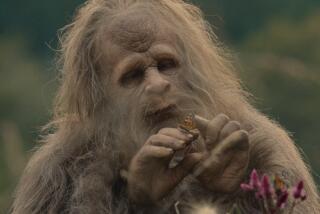Review: ‘North America,’ Discovery Channel’s 7-part nature series
Oh, nature, so near and yet so far: the thing we live in and deny, worship and destroy. The nagging conscience of our modern dystopian times!
It is spiritually useful to be reminded that there is a world of animals that -- for the moment, at least -- live their lives independent of human interference, on land that has not been subdivided, strip-malled, strip-mined, plowed up or plowed under. So, although in its framing, editing and analogizing it does impose a human framework on the unknowable intelligences of its subjects, we are thankful (on balance) for the seven-part “North America,” premiering Sunday on Discovery Channel.
The latest of Discovery’s blockbuster nature documentaries, after “Planet Earth,” “Life,” “Frozen Planet” and “Africa,” it’s also the first to be made apart from the BBC, whose Natural History Unit leads the league in such endeavors. Born of the technological marriage of modern cameras and television monitors, these films are gorgeous from first to last; it’s hard not to regard the images they offer -- not merely their content, but also the fact that anyone managed to take them in the first place -- as something like miraculous.
FULL COVERAGE: Television reviews
The fauna on display here ranges from great gray whales in the Bering Sea to colorful little birds in the Costa Rica jungle; in the first episode alone, there are bears and mountain goats and sea turtles -- oh my! There are wild mustangs, descended from the horses that Spanish explorers imported, and whose cousins, says narrator Tom Selleck at his croaky folksiest, “pulled the plow that broke the plains” and “gave the Native American a fighting chance against the white man. They are as American as the land itself.”
Indeed, the “Americanism” of animals that happen to live in a place people call America is a theme often returned to, in tones redolent of a GM truck commercial. “The home of the brave demands courage and sacrifice [crocodile eats bird]; she tests all who set foot on her soil; only those tough enough, resilient enough and bold enough to fight for what’s theirs [wolf bares teeth] earn the right to call her ... home.”
This aggressive tone is not wholly inappropriate. Eating and trying not to be eaten are among the most basic activities of life on Earth, and among its most dramatic (and, for that matter, prosaic). Nevertheless, from the corny alternation of slow and fast motion familiar from modern action films to the titles of the episodes (“No Place to Hide,” “Learn Young or Die,” “Life on the Savage Edge”), there is an obvious, lip-smacking delight on the muscular brutality of it all -- almost as if to remind you that you are watching the network of “Deadliest Catch” and “Naked Castaway.” (Sensitive children, not to say adult TV critics, may want to leave the room now and again. Fortunately, the bad moments are pretty clearly telegraphed.)
With a hectoring score (part fake Hans Zimmer, part bad rock music) abetting the overripe narration, “North America” is perhaps a trip best taken with the sound down.
It is interesting to learn of course that a grizzly’s sense of smell is 2,300 times more sensitive than mine, or that a mountain lion can jump 40 feet, that some of the rocky spires of Monument Valley are the eroded magma cores of ancient volcanoes and that the extremes of the North American climate are the result of its lacking an east-west mountain range to keep the cold Arctic air and the warm tropical air apart.
It’s less helpful to have the activity in a Costa Rican jungle be described in terms of a “Prohibition gin joint” or the dangerous passage of newly hatched sea turtles across the beach from the safety of their nests to the safety of the ocean compared at length to D-Day. The pictures will tell you what you need to know.
More to Read
The complete guide to home viewing
Get Screen Gab for everything about the TV shows and streaming movies everyone’s talking about.
You may occasionally receive promotional content from the Los Angeles Times.







